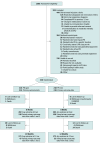Minimal vs Specialized Exercise Equipment for Pulmonary Rehabilitation: A Randomized Clinical Trial
- PMID: 40794408
- PMCID: PMC12344533
- DOI: 10.1001/jamanetworkopen.2025.26616
Minimal vs Specialized Exercise Equipment for Pulmonary Rehabilitation: A Randomized Clinical Trial
Abstract
Importance: Pulmonary rehabilitation (PR) improves exercise tolerance, symptom burden, and health-related quality of life for people with chronic respiratory conditions. However, demand for PR outstrips supply. Traditionally, PR has been delivered using specialist, gym-based exercise equipment.
Objective: To investigate whether PR using minimal equipment (PR-min) is noninferior to PR using specialist gym exercise equipment (PR-gym).
Design, settings, and participants: This parallel, 2-group, assessor- and statistician-blinded, noninferiority randomized clinical trial compared PR-min with PR-gym. Eligible participants were people with chronic respiratory disease referred for PR to the Regional Pulmonary Rehabilitation Unit in northwest London, UK. Recruitment occurred from October 15, 2018, to December 21, 2021, with a final follow-up to December 14, 2022. Randomization was by an independent web-based system using minimization with 1:1 allocation. Data analysis was performed from May 2023 to January 2025.
Interventions: Both PR programs comprised 2 in-person, outpatient supervised sessions per week for 8 weeks. PR-min used minimal equipment (eg, walking circuit and body weight exercises), whereas PR-gym used specialist exercise equipment (eg, treadmills and weights machines).
Main outcomes and measures: The primary outcome was change in incremental shuttle walk (ISW) distance after PR (ie, at 8 weeks; with a predefined noninferiority margin of -24 m). Secondary outcomes included dyspnea, health-related quality of life, costs, and adverse events.
Results: A total of 436 participants (median [IQR] age, 71.7 [63.2-77.7] years; 239 [54.8%] male) were enrolled, with 218 randomized to PR-min and 218 to PR-gym. At 8 weeks, PR-min (n = 136) and PR-gym (n = 130) demonstrated significant improvements in ISW distance with no significant between-group difference in ISW distance change (mean, 1.7 m; 1-sided 97.5% CI lower bound, -16.8), which was within the -24-m noninferiority margin. The intention-to-treat analysis and a robust range of sensitivity analyses all demonstrated that PR-min was noninferior to PR-gym. Similar findings were observed for dyspnea and health-related quality of life. No excess adverse events or costs were seen with intervention.
Conclusions and relevance: This randomized clinical trial found that PR-min demonstrated noninferiority to PR-gym for exercise capacity, dyspnea, and health-related quality of life. PR-min can expand the number of settings where PR can be provided, thus improving patient accessibility.
Trial registration: isrctn.org Identifier: ISRCTN16196765.
Conflict of interest statement
Figures


Comment in
- doi: 10.1001/jamanetworkopen.2025.26633
References
Publication types
MeSH terms
LinkOut - more resources
Full Text Sources
Research Materials

